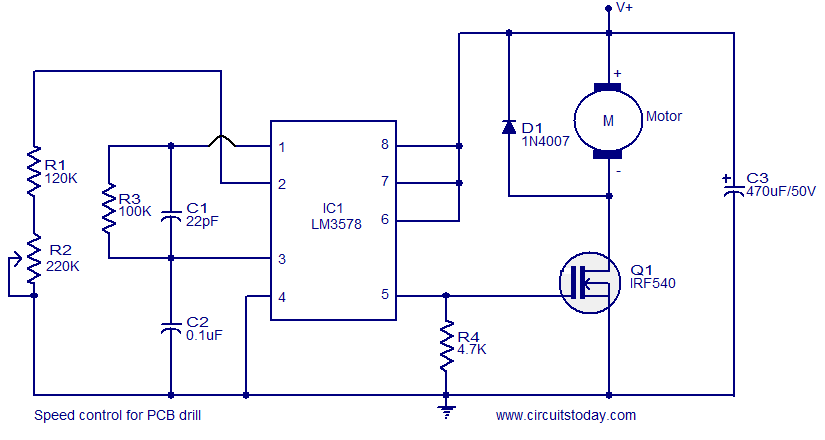Description.
Here is a simple circuit for controlling the speed of DC operated PCB drills. The heart of this circuit is the ICLM3578 which is a very efficient integrated switching regulator that can be used for applications like this. The LM3578 has separate inverting and non inverting feedback inputs (pin1 and pin2), 1V internal reference voltage source and a built in oscillator circuit. The IC can be configured to obtain up to 90% duty cycle. In the circuit, capacitor C2 is the timing capacitor which determines the frequency of the internal oscillator. The duty cycle depends on the sum of resistors R1 and R2 and it can be varied by adjusting the POT R2. The output PWM signal will be available at pin 5 of the IC. The Q1 drives the motor M according to the PWM signal available at pin5 and thus by varying the duty cycle of the PWM wave by varying POT R2, the speed of the motor can be adjusted. The diode D1 is a freewheeling diode which protects the MOSFET Q1 from transients produced by the motor. Capacitor C3 is just a filter capacitor.
Circuit diagram.
Notes.
- The circuit can be assembled on a Vero board.
- The supply voltage (V+) can be anything between 6 to 30V DC.
- The supply voltage (V+) must be selected according to the voltage rating of the drill motor.
- The maximum drain current IRF540 can handle is 22A @ room temperature.
- The duty cycle can be varied from 0 to 90% by adjusting the POT R2.


11 Comments
That is exactly what I need! But there is a problem, i can’t find the LM3578 ic, do you know any similar ic that could be used instead?
why the circuit didnt regulate? doesnt change the speed..
Check Q1 by disconnecting IC1 Pin no5 to Q1 gate should stop the motor from running if not Q1 is faulty. If Q1 is ok check all components around IC1 if all are ok replace IC1.
Hi, this is a great circuit, I am extending wires out to the trim pot and there seems to be some noise issues and motor stops spinning when touched at trim pot.
Do you have any suggestions to minimise this noise? Do you I should only use with trimpot soldered directly to PCB?
Thanks:)
Hi Abhi you can use a remote pot but proper screening and earthing should be taken care for proper operation, as stray pickup can result in malfunctioning.
Thanks for your response.
Twisted pair helps in my case.
I am using this circuit to turn my manual coffee grinder.
Motor needs high current to begin with about 4.6A, as a lot of torque is required to start turning the grinder.
I have set up my pots in a way that the motor is initially turned off and quickly gains speed if pot is cranked to its max.
With this setup if I slowly turn the pot I can start hearing the motor trying to turn and as I continue to slowly turn the pot to its max, motor fails to start spinning with my grinder setup.
I rather hear a high pitched squealing noise which almost feels current limited.
On the other hand if I crank the pot quickly to create a pulsing effect, the motor turns straight away.
I am thinking something along the lines of current limit on LM3578 @ Pin6, EMI of motor due to coil inductance or some sort of transient response of the motor that is affecting the chip. I may potentially need a filter at Pin 6? I am not sure.
Any suggestions would help…?
Thanks in advance.
Correction: Pin7** at LM3578 is current limit.
I have a question. If the temperature is below room temperature will this increase or decrease the amp rating on the IRF540? My temperature will be between 10°C to 25°C
never mind the ic….
the maximum current the IC LM 3578 can handle is 0.75A
will this be sufficient to drive big motors or this current is just required for driving the power mosfet IRF540.
reply to probir :
Maximum current LM3578 can handle is 0.75mA and it is not sufficient for big motors. The PWM signal from the IC drives the IRF540 and IRF540 drives the motor accordingly.IRF540 can easily handle currents up to 20A. The output current capability of the IC is well sufficient for driving the IRF540.